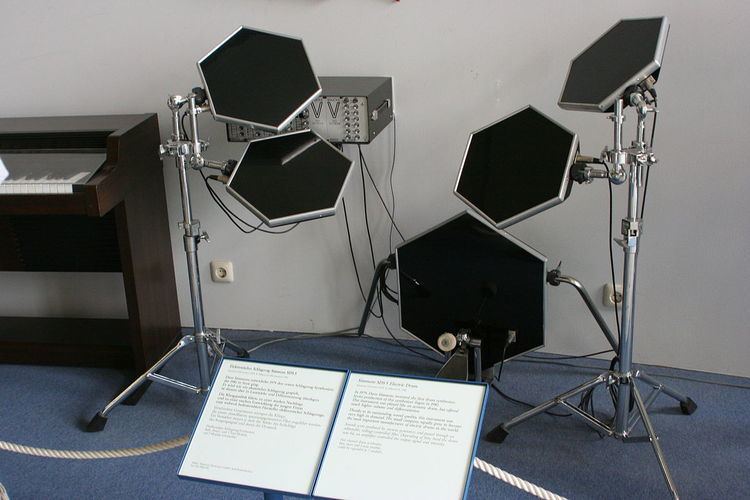 | ||
The Simmons SDS 5, SDSV, or Simmons Drum Synthesizer (notated as SDS-V on the following) was the first viable electronic replacement for acoustic drums. It was developed by Richard James Burgess and Dave Simmons, manufactured initially by Musicaid in Hatfield, UK, and commercially released in 1981. After Musicaid went bankrupt, Simmons set up a new manufacturing company under his name, Simmons.
Contents
Burgess pioneered the use of the SDS-V, triggering the prototype version with a Roland MC-8 Microcomposer in 1979 to make Landscape's groundbreaking computer-programmed futurist album From the Tea-Rooms of Mars... To the Hell-Holes of Uranus. Burgess's original concept had been to make a machine which could be played by a drummer as a replacement for acoustic drums. This idea was developed from dealing with the problems of audio spill via the microphones on a live stage and was fleshed out via an article he wrote for Sound International Magazine in 1979 called "Skin and Syn". He finally recorded the first example of the SDS-V to be played by a drummer in 1981 when he produced the Spandau Ballet hit, "Chant No. 1 (I Don't Need This Pressure On)", featuring John Keeble on the now famous hexagonal pads and the first production SDS-V 'brain', which immediately became popular with several 1980s musicians.
Idea
Burgess had been triggering electronics from his acoustic drums both live and in the studio throughout the 1970s, but he really wanted a drum synthesiser that would stand alone and would allow adjustment of the individual parameters of the drum sound. For live applications he realised some sort of sound memory would be essential so they came up with the cost-effective idea of four (adjustable) presets for each module which were preloaded so, even without programming experience, something decent could be coaxed out of it.
Pads
The pads were made from extremely hard plastic material that was used in police riot shields. They were robust and could take a serious beating, but many drummers complained of wrist and elbow ache. Subsequent versions of the SDS line introduced rubber pads that were kinder on drummers but many felt that the later revisions of the electronics lacked the character of the original SDS-V.
The futuristic hexagonal pads were Burgess's idea based on the idea of interlocking shapes and inspired by a honeycomb. Many other prototype shapes were tested including batwings and triangles, and there were a very limited number of production kits made that were known as the Rushmore headkits that featured fiberglass faces as the body/shell of the 'drum'.
Modules
The standard SDS-V was loaded with 5 modules: Bass, Snare and three Tom Toms, which looked almost identical, with controls for noise level, tone level, bend, decay time, noise tone (a simple filter) and click drum control which added extra attack derived from pad impact. Each module's parameters were optimised for the drum it was designed to emulate. Optional Cymbal and Hi-Hat modules were also available with open and closed hi-hats controlled from an external pedal. There was also a mixer section with individual volume control for each module (only into the mono/stereo output) and controls for pad sensitivity.
Outputs were balanced XLRs for live and studio applications (pins 1 & 2 ground, pin 3 hot), however the XLR pad input wiring on the SDS-V was unconventional - the User Manual states that pin 2 is hot and pins 1 & 3 are ground. Each module also had a 1/4" jack trigger input allowing triggering from various sources including the SDS-6 and even audio (for example from a drum machine).
